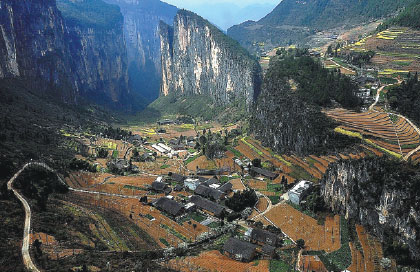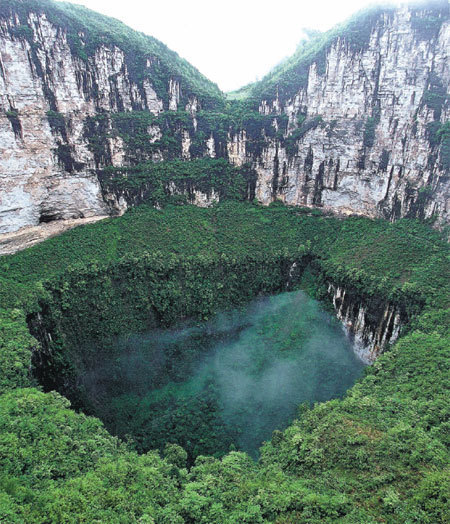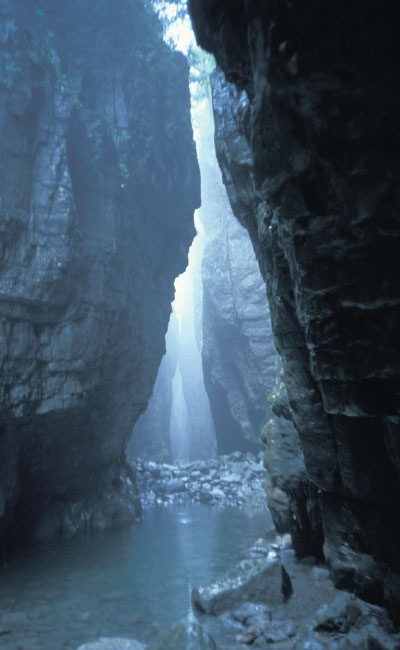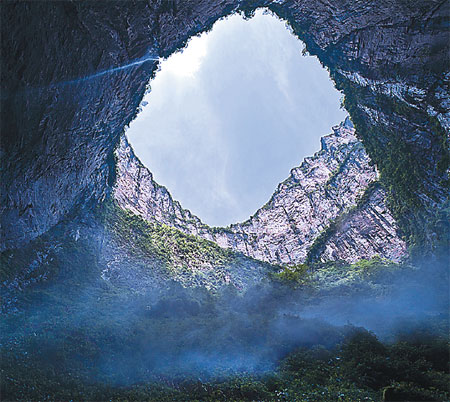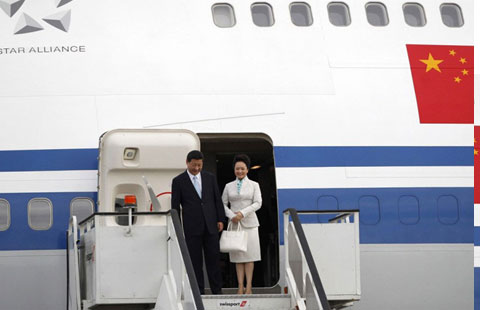Under world
Updated: 2014-07-21 07:16
By Luo Wangshu and Tan Yingzi (China Daily USA)
|
||||||||
The rugged terrain as visitors approach Tiankeng Difeng is a hint of the extraordinary landscape that awaits them in this underground wonderland. Luo Wangshu and Tan Yingzi explore a unique spot in Chongqing.
Asinkhole nestled in the depth of mountains in Fengjie county, Chongqing, remained unknown to the outside world until a group of British explorers from the Royal Geographical Society stumbled across it in 1994. Its fame has been spreading all over the world ever since.
Acclaimed as a wonderland in Southwest China, it's called Tian-keng Difeng by locals - literally "the sky hole and earth cave".
Located at one of the Three Gorges, Qutang Gorge, the site is a fine example of how nature works its magic to create a fantastic landscape.
The "sky hole", one of the world's deepest of its kind, is more than 600 meters deep with vertical walls. Its opening is about 600 meters long and 500 meters wide.
China National Geography, one of the country's top travel magazines, depicts the sinkhole as a hidden paradise filled with peach blossoms in the spring, like a utopia described by Chinese ancient poet Tao Yuanming (AD 365-427).
We were fortunate to explore this paradise in the spring - the best time.
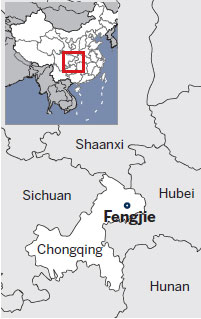
The sinkhole and its crust are located in Xiaozhai village on Qiyao Mountain. Our car departed from the town center of Fengjie county in early morning and traveled through the heavy fog.
The county is located on hills, which challenges new drivers' nerves. Our car went up and down for about 15 minutes and passed across a bridge over the Yangtze River.
Suddenly the mountain appeared in front of us. Orange trees are planted on both sides of the road, and their fragrance combined with the fog to provide a mysterious prelude to our trip.
After an hour of climbing along the Jiupan River, we finally arrived.
The wall of the sinkhole forms a nearly 90-degree angle, as if the mountain had been cut by a cake knife.
"The rocks inside the sinkhole have been dissolved and carried away by the river. Water is stronger than rocks here. In autumn when leaves turn red, the mountain and the sinkhole look like a colorful painting," says Ran Wei, a tour guide.
The sinkhole is a nested double structure - the upper bowl is 320 meters deep and the lower bowl is 342 meters deep.
Staring down the hole from above, we saw mostly green. But as we looked carefully, it was easy to spot some pink - the peach blossoms.
We spent about two hours walking from the top to the bottom along the 2,800-step stairway.
An underground river runs through the bottom of the sinkhole into a nearby cave called Difeng.
However, the path between the "sky hole" and the cave has not been found. To pay a visit to the cave, we had to climb up the sinkhole. The trip was challenging for many visitors.
"It was not easy for us seniors to walk down to the bottom and climb up," says a woman in her 60s surnamed Li from Hubei province. She and her husband took about five hours to make the trip.
But the view is worth the effort, she says.
The nearby Difeng cave has also attracted explorers from China and abroad since it was brought to the world's attention in 1994 - though according to the China National Geography, no one has passed all the way through it.
From afar, the cave looks like a narrow gap in the green landscape. The cave is 14 kilometers long and 10 to 30 meters wide, becoming narrower when it goes deeper.
At the bottom of the cave, the width is about 1 to 15 meters. The deepest part of the cave is 229 meters. However, the bottom of the underground river has not been reached.
"The cave remains a mystery, waiting for more explorers," the magazine says.
Contact the writers through luowangshu@chinadaily.com.cn
FINDING FENGJIE'S SWEET SIDE
Besides beautiful landscapes, Fengjie county in the northeast of Chongqing has another attraction for visitors - oranges. The county is one of the nation's major production areas of the fruit.
At an orange farm, visitor Chen Peng is excited to pick oranges from the trees and eat them up.
"The oranges are very fresh and juicy. With the fresh air and country view, it is a worthwhile trip for city dwellers," he says.
"After exploring the sinkhole and the cave, orange picking is relaxing," Chen says.
Orange farms in Fengjie have expanded to 20,000 hectares, according to 2013 figures. The total output of oranges was 230 million kg, which earned the local farmers a total of 1.13 billion yuan ($181 million), according to Zhu Mao, head of the county.
"About 30 percent of the population in Fengjie makes a living from orange trees," Zhu says. The county has 300,000 orange famers, and many of the farms are open to visitors.
IF YOU GO
The entrance ticket is 80 yuan ($13). There are multiple ways for visitors from Chongqing to get to Fengjie, bus, train and ship, and these take from six to about 12 hours. The bus is the easiest way, and the one-way ticket is about 170 yuan.
|
A small village is nestled in the depth of mountains near the Tiankeng Difeng scenic spot in Fengjie county, Chongqing. He Chuan / China Daily |
|
The 600-meter-deep sinkhole in Fengjie county, Chongqing, is coated with green vegetation in spring. Zhang Sanyou / For China Daily |
|
An underground river runs through the bottom of the sinkhole to a nearby cave. Provided to China Daily |
|
The sinkhole in Fengjie county, Chongqing, is one of the deepest of its kind in the world. Jian Zhiyun / For China Daily |
(China Daily USA 07/21/2014 page10)

 Xi in Venezuela for third stop on Latin tour
Xi in Venezuela for third stop on Latin tour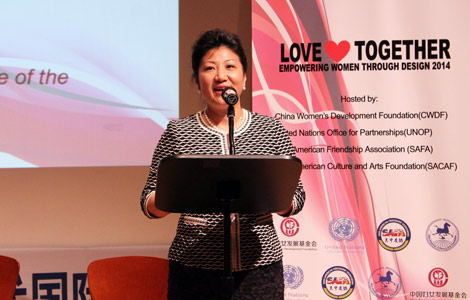
 Cultural divide appears at symposium on empowering women
Cultural divide appears at symposium on empowering women
 China-Venezuela ties riding on fast track
China-Venezuela ties riding on fast track
 Xi gets Argentine welcome
Xi gets Argentine welcome
 Young Chinese soccer players join stars
Young Chinese soccer players join stars
 President Xi tours Argentina
President Xi tours Argentina
 The 'Yao Ming' of boxing debuts with KO
The 'Yao Ming' of boxing debuts with KO
 China Argentina sign deal on dams
China Argentina sign deal on dams
Most Viewed
Editor's Picks

|

|

|

|

|

|
Today's Top News
China, Cuba to further advance ties
Xi arrives in Venezuela for state visit
Chinese students rank highest in financial literacy test
Chinese President Xi leaves for Venezuela
Black boxes of MH17 under 'control': rebels
China's Sany ready to act on US govt move
Super typhoon Rammasun batters China, killing 18
China, Argentina seek closer cooperation
US Weekly

|

|
